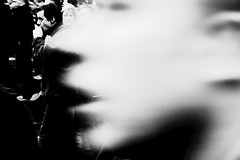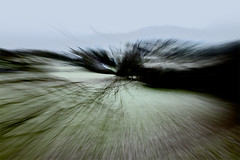Musings on creativity for photographers and artists by Rob Hudson
Saturday 5 June 2010
Why golden hour photography isn't enough
I was going to write a separate piece here, but my thoughts were hijacked by a discussion in Flickr's Art of Landscape group http://www.flickr.com/groups/art_of_landscape/.
So here is my response to the question of orange and purple landscapes.
What do we all want out of photography? Whoever we are budding amateur, professional landscape photographer, artist? It is quite simply a form of self-satisfaction. Now that is inevitably a different thing for different people and different times or stages of their development. But in some people that may eventually turn into a desire to produce something that is (at least in relative terms) unique to themselves. For that to happen requires a degree of introspection to examine what about the landscape is important to them.
Every photographer should be turned on by light; “photography” is after all Greek for writing with light. But, speaking from personal experience, this can lead to a limited response to the landscape. Just try a personal brain storming session about what the landscape really means to you, also remember that meanings haven’t always been static, I find it useful to think back to childhood responses. Throw some keywords onto the page. Here are some examples -
Exposed, intimate, polluted, clean, hot, cold, windy, still, fear, contentment, lost, dark, bright, joy, freedom, escape, ethereal, delicate, huge, private, enclosed, open.
I could go on and on, but this is about you not me.
Now just ask yourself if the Golden Hour alone is the right way to express many of those thoughts, ideas or emotions? I would argue that it’s unsuitable for many of them. It is a question of depth; art requires more than surface beauty, as we are both intellectual and emotional beings, satisfying only half our brains is a frustrating experience. The first step to getting deeper is to get away from the beach and sunsets. Landscape is about so much more than that.
In the world of artistic expression technique becomes subordinate to ideas, it is something that can and should be harnessed to address the concept or theme. That doesn’t necessarily mean throwing out the rulebook, but giving consideration to how technique can be melded to purpose. The problem for me with many golden hour image-makers is that there is no room for manoeuvre; technique becomes a fixed method, a method that can only produce a certain type of image.
Art isn’t so much nebulous, as an answer without a question. To paraphrase Douglas Adams “if that is the answer what is the question?” You’ll have to find your own answers to your own questions. To think in purely visual terms probably wont answer many questions, for that you’ll need to think more like a poet and then turn those thoughts into imagery.
Sunday 21 March 2010
The Past: What other home do I have?
Know thy self. That's the impossible goal we set ourselves, not just in creative realms, but in just about every piece of psychoanalysis, religion and even wardrobe shopping for crying out loud! But just how do you set out to "know yourself"? What the hell is it that defines "you", what is it that makes "you" unique and separates "you" from the guy next door? And once that is answered, how can we harness it to creative ends.
Some time ago I wrote a piece over on my Flickr site about how who I am can influence my creative output. The difficulty was “the elusive ‘I’ shows an alarming tendency to disappear when we try to examine it”. Well I've had 9 months to ponder that little conundrum and I think it's time I shared some thoughts, but this time in a proper blog form.
The simple answer is of course the past. If there is anything that is unique it is your history. Fingerprints pale into insignificance, retinal scans are mere snapshots, your history is the building blocks of you. Friends, relatives, relationships, experiences, health (or lack of it), travel, politics, education etc are not just of the now, they are of a sequence of interconnecting stimuli to existence.
You'll notice I haven't mentioned art in the list above. I don't mean art can't influence your work, but that you're treading dangerous waters there, the possibilities of becoming over influenced or plagiarism are obvious, but more so it isn't part of YOU, it is somebody else's self expression, their way of seeing, their past. Learn from fellow artists more a way of thinking than a way of seeing.That was the big mistake on my Flickr site, misinterpreting artistic influence as an element of myself and worse failing to see the personal in my interpretation.
"We see with memory, which is why none of us sees the same thing, even when we're looking at the same thing"
David Hockney
You'll notice I haven't mentioned art in the list above. I don't mean art can't influence your work, but that you're treading dangerous waters there, the possibilities of becoming over influenced or plagiarism are obvious, but more so it isn't part of YOU, it is somebody else's self expression, their way of seeing, their past. Learn from fellow artists more a way of thinking than a way of seeing.That was the big mistake on my Flickr site, misinterpreting artistic influence as an element of myself and worse failing to see the personal in my interpretation.
"We see with memory, which is why none of us sees the same thing, even when we're looking at the same thing"
David Hockney
The past is all we have, there isn't anything else that makes us "us", it is our sole point of reference and our only route into self awareness. It is worth thinking in terms of two different (but interconnected) pasts for the creative artist, the personal and the creative influence. For the latter it is essential to become aware of the past creative influences, including your own. Think of it as expanding your artistic vocabulary in a visual language. Most obviously you need to study art and photographic history so that you don't end up unknowingly repeating what has already been done. But you'll really need to get under that creative skin, to read around your subjects work and inform yourself of the reasoning and rational behind the works, while of course keeping a weather eye open for the pretensions, platitudes and frankly lies of which many visual artists are guilty. Find those "ways of thinking" that inspire you and apply them to yourself and your work, adding, multiplying, deleting and minimising as you go, there's a huge amount of thought and creative endeavour that has been put into the creation of art over centuries and you can't afford to ignore it. Much less expect to produce anything near originality.
This study shouldn't though be a vacuous exercise in knowledge, you have to study the creative past in order to know as Martin Scorsese put it in a recent interview what you "accept, reject, complain about. hate, love, whatever!" You Tube It's all going to add up to be a a vital part of the "structural engineering" of your work.
But for the façade, you'll need to be referring back to yourself. You may think you've led an unremarkable life and therefore nothing is worth sharing, well in truth nearly everyone leads unremarkable lives (including me), it is that which is our common experience which means your and my experiences will share a common bond. It is this very commonality which will be the touchstone of personal reference which is the hallmark of great art. Have you ever noticed how much of contemporary late twentieth century photography focusses on the mundane? That is surely because the mundane is a shared experience, it would be hard not to avoid it, but they take it further, expressing the wish for the mundane to be seen as beauty. If we all bought that concept, then wouldn't life be a richer experience? The trouble is most people don't buy it, it is just too bland and facile to be seen as art, perhaps we should strive just a little harder to look into ourselves and find those commonalities and maybe the dividing lines between us, no matter how small - they are what makes us interesting!
In my next post I'll try to show you a route to expressing the knowledge and individuality through the example of my recent Memories, Dreams and Reflections project.
Labels:
art,
barriers,
creative skin,
creativity,
humanity,
meaning,
memory,
past,
photography,
rob hudson,
self expression
Subscribe to:
Posts (Atom)



